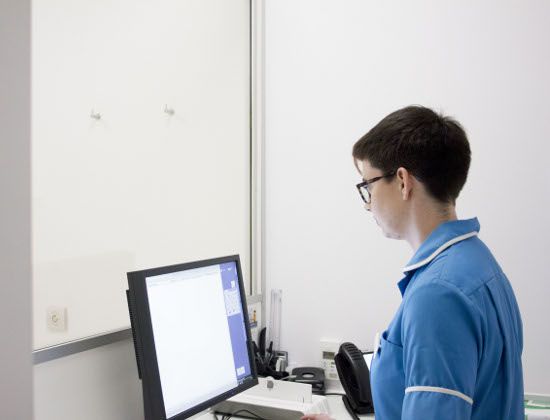Kienböck’s disease
This condition is caused by a lack of blood supply to the lunate, a small bone in the wrist, which can cause the bone to die (also known as osteonecrosis). Over time, Kienböck’s disease can cause pain, stiffness and osteoarthritis.
The disease normally progresses in four stages:
Stage 1: you may think you have sprained your wrist and, even though there is a lack of blood supply to the lunate, this may not show up on an X-ray (MRI scans tend to be more accurate).
Stage 2: the bone starts to harden (this is known as ‘sclerosis’) because it isn’t receiving enough blood to keep it healthy. It becomes easier to diagnose using an X-ray and MRI or CT scan. You will probably experience more pain, swelling and tenderness in the wrist.
Stage 3: as the bone hardens, it begins to break up and can affect other bones around it, moving them out of place (displacement). Your pain levels are also likely to increase and you may find it more difficult to move your wrist freely.
Stage 4: the bone becomes arthritic as bones around the lunate become increasingly damaged.
Causes
Although no one is sure exactly what causes Kienböck’s disease, the following are known to increase the risk:
- Having only one blood vessel supplying the lunate bone (most people have two)
- Having forearm bones (radius and ulna) of different lengths; this can put pressure on the lunate when the wrist is moved
- Having had one or more fractures of the wrist
- Putting your wrist into extreme positions or repeatedly weight-bearing on the wrist; gymnasts, for example, are more likely to be affected
Symptoms
These include pain (which can also affect the forearm), stiffness, tenderness and swelling in the wrist, restricted movement, and a weakened grip. Symptoms usually become worse as the disease progresses.
Diagnosis
Diagnosing Kienböck’s disease can be difficult; people often put their problems down to a sprained wrist and delay seeking advice. However, discussing your symptoms with your doctor, along with having an X-ray and MRI scan, can usually help to diagnose the condition.
Treatment
Non-operative treatment: taking anti-inflammatory medication (if advised by your doctor) can help relieve symptoms such as pain and swelling. Your specialist may also recommend immobilising your wrist with a cast or splint for a few weeks to relieve pressure from the lunate.
Surgery: if your symptoms don’t improve you may need to have surgery. Depending on your individual symptoms and how far the disease has progressed, surgery may involve:
- Revascularisation - this involves grafting a healthy pieces of bone (possibly from your forearm) that has its own blood supply onto the lunate bone to restore the blood supply
- Joint levelling - this procedure can help stop the condition becoming worse in patients whose arm bones are uneven lengths; the surgeon, either lengthens or shortens one of the bones
- Proximal row carpectomy - this procedure, which is less common and only performed if the disease is advanced, involves removing the lunate altogether, along with two bones either side; this relieves pain but still allows the wrist to move (although not fully)
- Fusion - wrist bones nearby can be joined to relieve pressure on the lunate and improve symptoms; you should still be able to move your wrist (although not fully). If you already have arthritis as a result of the condition, your surgeon may fuse all the wrist bones to help your hand function better and relieve pain; however, although you will still be able to move your forearm, your wrist movement will be very limited
Important: This information is only a guideline to help you understand your treatment and what to expect. Everyone is different and your rehabilitation may be quicker or slower than other people’s. Please contact us for advice if you’re worried about any aspect of your health or recovery.




















